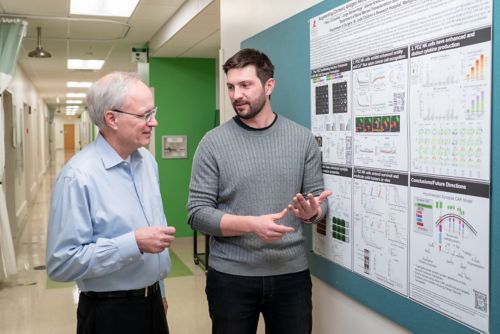St. Jude Family of Websites
Explore our cutting edge research, world-class patient care, career opportunities and more.
St. Jude Children's Research Hospital Home

- Fundraising
St. Jude Family of Websites
Explore our cutting edge research, world-class patient care, career opportunities and more.
St. Jude Children's Research Hospital Home

- Fundraising
Scientists can reprogram immune cells to target cancer cells by adding engineered chimeric antigen receptor (CAR) proteins to their surface. Researchers at St. Jude have found a way to “anchor” the CAR molecule within immune cells by adding four specific amino acids to the end of the conventional CAR. The molecular anchor concept was designed to improve CAR-based immunotherapies, which have demonstrated success in certain cancers, such as relapsed leukemia, but have yet to deliver that same success in solid tumors.

Senior author Stephen Gottschalk, MD (left), and corresponding author Peter Chockley, PhD (right), demonstrated that anchored CARs increased the survival of multiple solid tumor models.
The addition of a molecular anchor enabled the immune cells to be more easily activated and kill cancer cells more effectively than their conventional counterparts. In a paper published in Nature Biotechnology, the team demonstrated that the anchored CARs increased the survival of multiple solid tumor models, including lung, bone, and brain cancers.
“The anchor domain discovery is easily translatable into early phase clinical testing; it doesn’t require any other new technology,” said senior author Stephen Gottschalk, MD, Department of Bone Marrow Transplantation and Cellular Therapy chair. “We strongly believe this approach needs testing in the clinic because no one has tried it before, and it looks very promising from our preclinical work.”
CARs are a key molecule in the cancer-killing process. The outside of the molecule recognizes a protein on the cancer cell and forms a complex of molecules and proteins between the two cells, called an immune synapse. As the immune synapse forms, signals from the CAR trigger the immune cell to activate and kill the cancer cell. However, these communications can be muddled, making it challenging for conventional CAR T cells and natural killer cells to interpret.
“Our approach is different because it focuses on organization,” explained first and corresponding author Peter Chockley, PhD, postdoctoral fellow in the Department of Bone Marrow Transplantation and Cellular Therapy. “CAR immune cells form synapses that are very disorganized. The anchoring domain we added organizes internal scaffolding proteins, making a better synapse, and then brings in other extant signaling proteins. The simple addition of organization improves CARs dramatically.”
By adding the four amino acids to the CAR sequence, the group tuned the signals within the immune synapse. The amino acids specifically bind the protein Scribble, which is involved in creating an ordered scaffolding system of other proteins. This scaffolding system enables efficient communication and an effective immune response to tumors.
“The most attractive thing about this approach,” said Gottschalk, “is that you can add the anchor domain to any CAR or other antigen-specific receptor you like. The engineering is simple and easily translatable to a broad range of cellular immunotherapies that are currently being developed.”